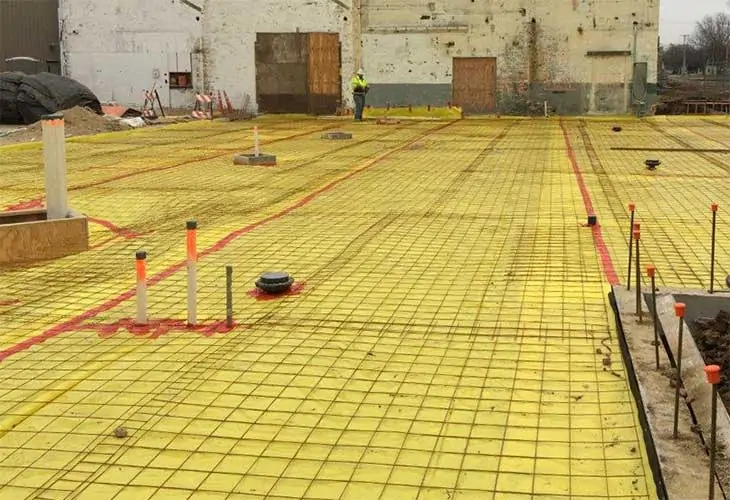


Vapor intrusion is a regulatory hot button gaining traction on states’ radar nationwide. This is driven by a growing understanding of how vapors travel through the soil into structures, posing health risks to occupants, coupled with research showing volatile vapors can be problematic even at very low concentrations.
As in California, conservative assumptions by regulatory agencies call for careful due diligence during the assessment process. These salient concerns recently brought a real estate developer in Monrovia to seek a professional engineer.
The client plans to convert a commercial property to residential use. But before moving forward, it needs to assess potential environmental issues associated with the property. That’s where SCS comes in, drawing on its concrete knowledge base in geology and chemistry—and leveraging its grasp of regulatory requirements.
The work in Monrovia entails a detailed soil vapor assessment, looking for volatile organic compounds (VOCs); the discovery at this site came as little surprise to Julio Nuno, Senior Vice President, and Project Director, as these constituents are often found during evaluations of this kind.
Assessing for VOCs
In this case, the soil contained eight VOCs, some at non-compliant levels. The good news is, after an extensive, multi-step vetting process, Nuno and his team came up with a relatively inexpensive solution to tackle a potentially daunting problem.
“As part of the soil vapor assessment, we compare concentrations we find on-site to screening levels established by the Department of Toxic Substances Control. We often see levels in exceedance of regulatory thresholds, particularly in industrial areas with releases that can travel from groundwater to soil into the building through the slab,” Nuno says.
Most prominent at the Monrovia site were two chlorinated compounds that have been used as solvents in industrial applications: tetrachloroethylene, also called PCE, and trichloroethene, or TCE. PCE is commonly present in industrial settings and communities as drycleaners widely and routinely used the chemical for decades.
Nevertheless, the work begins even before confirming VOC levels and other specifics around these compounds. The first step is a Phase I Environmental Assessment looking to see if past use of the property or surrounding property may have left a significant environmental impact. The SCS team discovered the adjacent property had a release of VOCs they identified as a ‘recognized environmental condition,’ meaning it needs further evaluation using a Phase II to determine if vapors could migrate onto the client’s property.
During the Phase II Environmental Assessment –the collection of soil and soil vapor samples –the SCS team gets even more specific, determining what’s present, specific locations, what degree of contamination, and what these findings mean for redeveloping the property and its final use.
“We confirm subsurface concentrations and if they exceed state screening levels, and if the site represents a potential risk for future residential use. The information informs our possible solutions to mitigate any migration of certain VOCs into the building and the indoor air,” Nuno explains.
Redevelopment Goals – safety and cost containment
Safety comes first, but containing project costs is a priority, which comes down to knowing design options, how to piece components together with both function and economics in mind. At this site, achieving safety and controlling costs centered largely around looking at the mandatory infrastructure– a ventilation system for a planned underground parking garage to prevent accumulation of carbon monoxide and other vehicle exhaust emissions.
“We knew the underground parking would require a ventilation system. It makes sense to look at the parameters associated with that design to verify if it serves dual purposes to ventilate the garage and mitigate the potential for VOCs to enter the building,” Nuno says.
By studying air exchanges that would occur, the number of times replacing air-containing pollutants with cleaner air per hour, Nuno gets his answer. “We determined that a second, separate system would not be necessary for sufficient ventilation; the assessment enabled us to confirm vapors would not travel into the residential portion of the building.”
The client can save $50,000 to $75,000 in capital expenses upfront while achieving their safety goals and avoids ongoing operations and maintenance costs for added infrastructure.
An added layer of protection
Identifying the issues for site developers and their tenants, then plotting the best course of action to ensure safety and regulatory compliance takes experience and knowledge. SCS devises a soil monitoring plan, alerting developers of indications of potential contamination to the soil, of odor, or anything unusual that could suggest an environmentally adverse condition. The plan advises on how to respond should there be an unexpected condition adding a further protection layer.
“It’s essential that an engineer understand the applicable federal, state, and local standards for completing assessments, as well as understand regulatory stipulations. You must also know the variations in those stipulations to effectively design a sustainable plan,” Nuno says. “In Monrovia, we comply with the Department of Toxic Substances Control requirements, the requirements of the Los Angeles Regional Quality Control Board, and others. Each has specific stipulations for evaluating each contaminant. So, we stay on top of which rules apply to which location,” he says.
Nuno has submitted a draft report for review by his client and its legal counsel; he’ll meet with them to discuss findings and explain their meaning. SCS includes an executive summary, explaining in plain language what is salient; often, a backup report includes thousands of pages. “It’s a lot of complex information, so we work on the language,” Nuno says.
“It’s important to paint an accurate picture and use terms that all parties, whether the client, investors, or other stakeholders understand. These redevelopments are major projects with many due diligence considerations. We want to provide accurate findings and recommendations that the client and their advisors can digest to help them with their decision making.”
More resources: